Tristan Glatard
Department of Computer Science and Software Engineering, Concordia University, Montréal, QC, Canada
Scaling up ridge regression for brain encoding in a massive individual fMRI dataset
Mar 28, 2024Abstract:Brain encoding with neuroimaging data is an established analysis aimed at predicting human brain activity directly from complex stimuli features such as movie frames. Typically, these features are the latent space representation from an artificial neural network, and the stimuli are image, audio, or text inputs. Ridge regression is a popular prediction model for brain encoding due to its good out-of-sample generalization performance. However, training a ridge regression model can be highly time-consuming when dealing with large-scale deep functional magnetic resonance imaging (fMRI) datasets that include many space-time samples of brain activity. This paper evaluates different parallelization techniques to reduce the training time of brain encoding with ridge regression on the CNeuroMod Friends dataset, one of the largest deep fMRI resource currently available. With multi-threading, our results show that the Intel Math Kernel Library (MKL) significantly outperforms the OpenBLAS library, being 1.9 times faster using 32 threads on a single machine. We then evaluated the Dask multi-CPU implementation of ridge regression readily available in scikit-learn (MultiOutput), and we proposed a new "batch" version of Dask parallelization, motivated by a time complexity analysis. In line with our theoretical analysis, MultiOutput parallelization was found to be impractical, i.e., slower than multi-threading on a single machine. In contrast, the Batch-MultiOutput regression scaled well across compute nodes and threads, providing speed-ups of up to 33 times with 8 compute nodes and 32 threads compared to a single-threaded scikit-learn execution. Batch parallelization using Dask thus emerges as a scalable approach for brain encoding with ridge regression on high-performance computing systems using scikit-learn and large fMRI datasets.
Classification of Anomalies in Telecommunication Network KPI Time Series
Aug 30, 2023

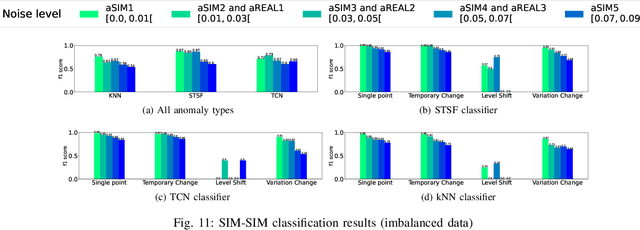

Abstract:The increasing complexity and scale of telecommunication networks have led to a growing interest in automated anomaly detection systems. However, the classification of anomalies detected on network Key Performance Indicators (KPI) has received less attention, resulting in a lack of information about anomaly characteristics and classification processes. To address this gap, this paper proposes a modular anomaly classification framework. The framework assumes separate entities for the anomaly classifier and the detector, allowing for a distinct treatment of anomaly detection and classification tasks on time series. The objectives of this study are (1) to develop a time series simulator that generates synthetic time series resembling real-world network KPI behavior, (2) to build a detection model to identify anomalies in the time series, (3) to build classification models that accurately categorize detected anomalies into predefined classes (4) to evaluate the classification framework performance on simulated and real-world network KPI time series. This study has demonstrated the good performance of the anomaly classification models trained on simulated anomalies when applied to real-world network time series data.
Numerical Uncertainty of Convolutional Neural Networks Inference for Structural Brain MRI Analysis
Aug 03, 2023Abstract:This paper investigates the numerical uncertainty of Convolutional Neural Networks (CNNs) inference for structural brain MRI analysis. It applies Random Rounding -- a stochastic arithmetic technique -- to CNN models employed in non-linear registration (SynthMorph) and whole-brain segmentation (FastSurfer), and compares the resulting numerical uncertainty to the one measured in a reference image-processing pipeline (FreeSurfer recon-all). Results obtained on 32 representative subjects show that CNN predictions are substantially more accurate numerically than traditional image-processing results (non-linear registration: 19 vs 13 significant bits on average; whole-brain segmentation: 0.99 vs 0.92 S{\o}rensen-Dice score on average), which suggests a better reproducibility of CNN results across execution environments.
Numerical Stability of DeepGOPlus Inference
Dec 13, 2022Abstract:Convolutional neural networks (CNNs) are currently among the most widely-used neural networks available and achieve state-of-the-art performance for many problems. While originally applied to computer vision tasks, CNNs work well with any data with a spatial relationship, besides images, and have been applied to different fields. However, recent works have highlighted how CNNs, like other deep learning models, are sensitive to noise injection which can jeopardise their performance. This paper quantifies the numerical uncertainty of the floating point arithmetic inaccuracies of the inference stage of DeepGOPlus, a CNN that predicts protein function, in order to determine its numerical stability. In addition, this paper investigates the possibility to use reduced-precision floating point formats for DeepGOPlus inference to reduce memory consumption and latency. This is achieved with Monte Carlo Arithmetic, a technique that experimentally quantifies floating point operation errors and VPREC, a tool that emulates results with customizable floating point precision formats. Focus is placed on the inference stage as it is the main deliverable of the DeepGOPlus model that will be used across environments and therefore most likely be subjected to the most amount of noise. Furthermore, studies have shown that the inference stage is the part of the model which is most disposed to being scaled down in terms of reduced precision. All in all, it has been found that the numerical uncertainty of the DeepGOPlus CNN is very low at its current numerical precision format, but the model cannot currently be reduced to a lower precision that might render it more lightweight.
Dynamic Ensemble Size Adjustment for Memory Constrained Mondrian Forest
Oct 11, 2022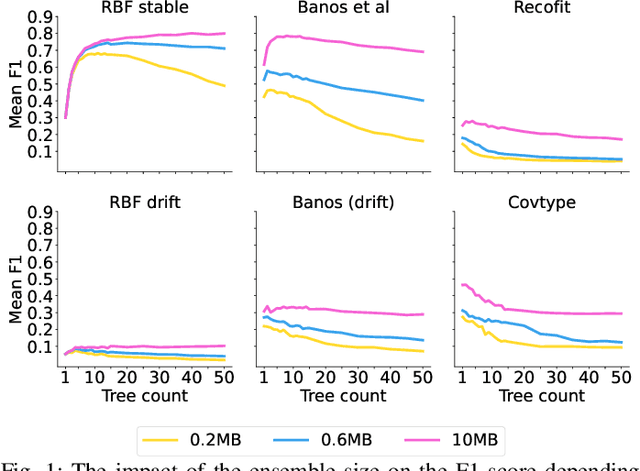
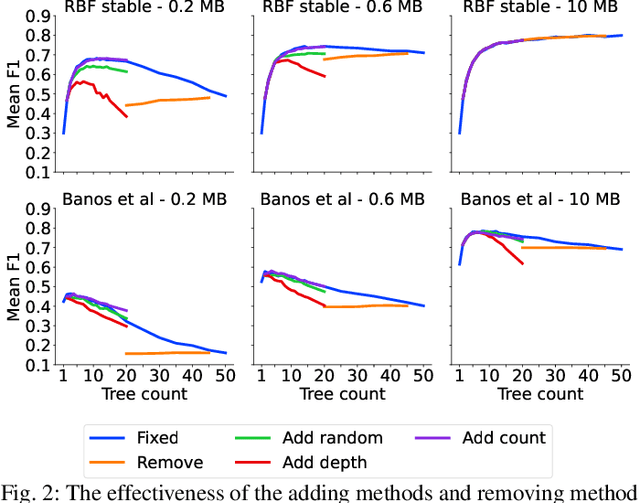
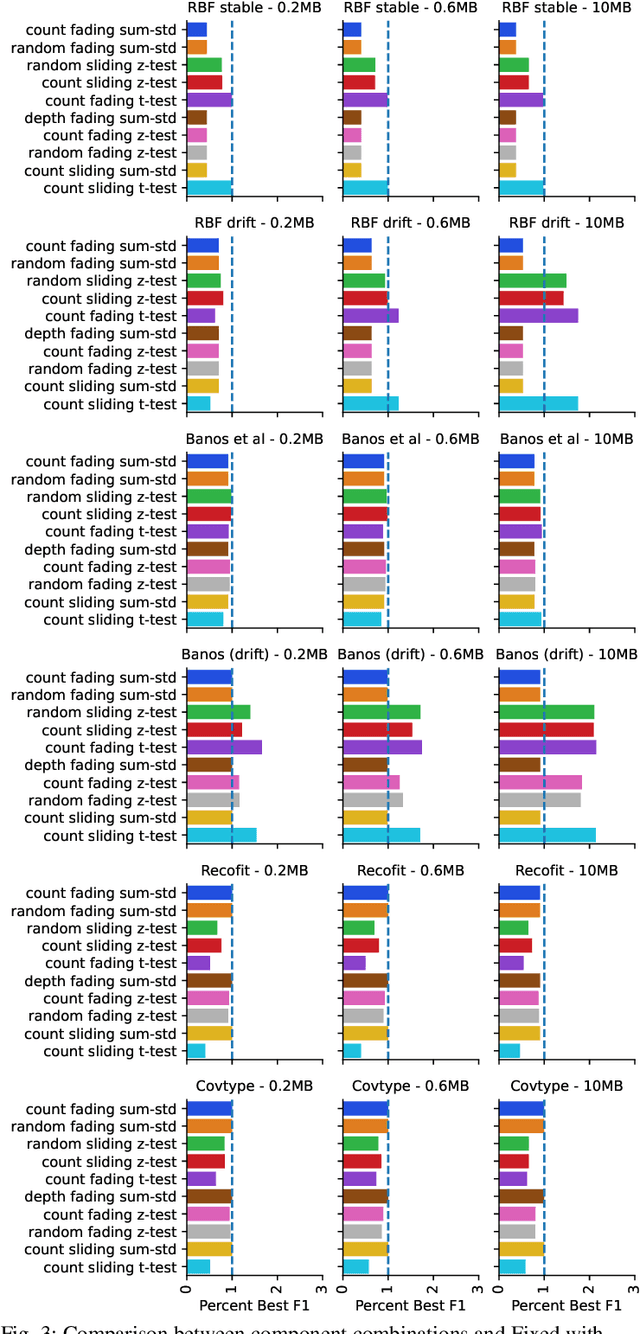
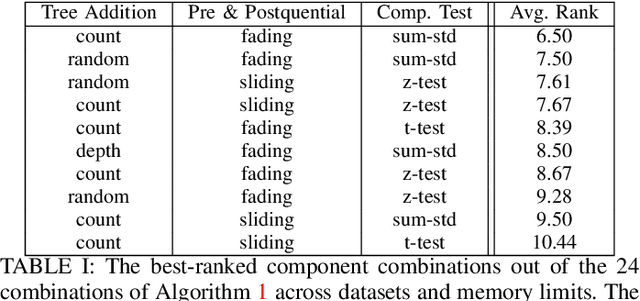
Abstract:Supervised learning algorithms generally assume the availability of enough memory to store data models during the training and test phases. However, this assumption is unrealistic when data comes in the form of infinite data streams, or when learning algorithms are deployed on devices with reduced amounts of memory. Such memory constraints impact the model behavior and assumptions. In this paper, we show that under memory constraints, increasing the size of a tree-based ensemble classifier can worsen its performance. In particular, we experimentally show the existence of an optimal ensemble size for a memory-bounded Mondrian forest on data streams and we design an algorithm to guide the forest toward that optimal number by using an estimation of overfitting. We tested different variations for this algorithm on a variety of real and simulated datasets, and we conclude that our method can achieve up to 95% of the performance of an optimally-sized Mondrian forest for stable datasets, and can even outperform it for datasets with concept drifts. All our methods are implemented in the OrpailleCC open-source library and are ready to be used on embedded systems and connected objects.
Mondrian Forest for Data Stream Classification Under Memory Constraints
May 12, 2022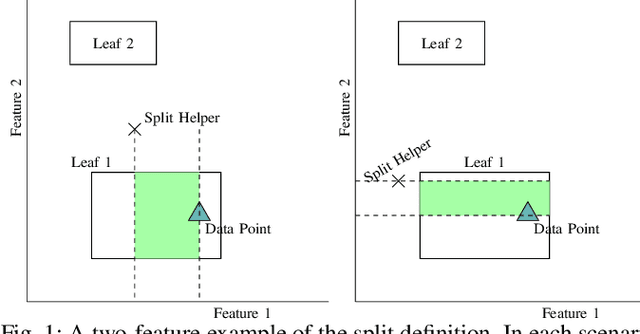
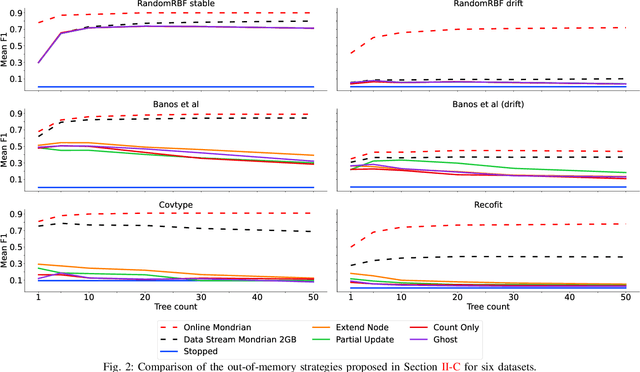
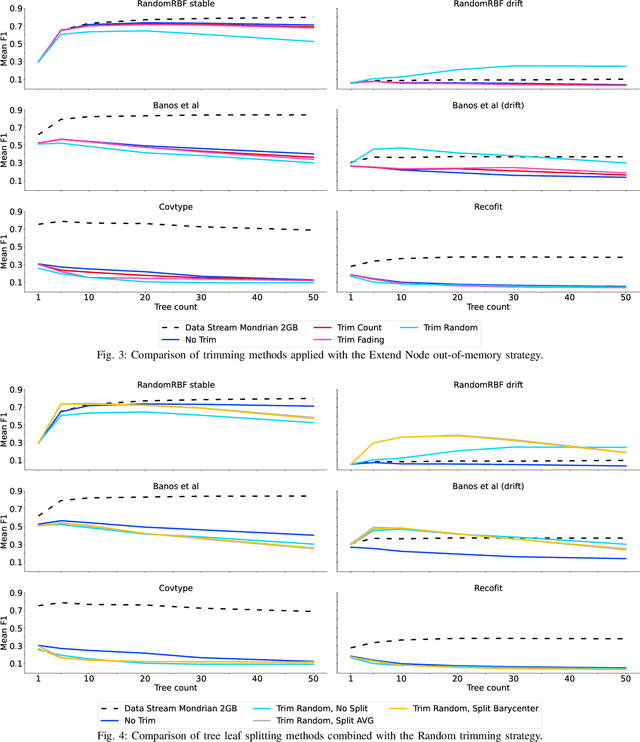
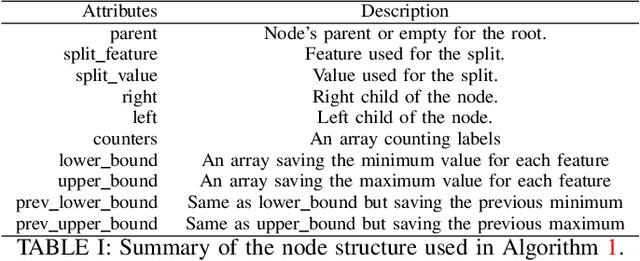
Abstract:Supervised learning algorithms generally assume the availability of enough memory to store their data model during the training and test phases. However, in the Internet of Things, this assumption is unrealistic when data comes in the form of infinite data streams, or when learning algorithms are deployed on devices with reduced amounts of memory. In this paper, we adapt the online Mondrian forest classification algorithm to work with memory constraints on data streams. In particular, we design five out-of-memory strategies to update Mondrian trees with new data points when the memory limit is reached. Moreover, we design trimming mechanisms to make Mondrian trees more robust to concept drifts under memory constraints. We evaluate our algorithms on a variety of real and simulated datasets, and we conclude with recommendations on their use in different situations: the Extend Node strategy appears as the best out-of-memory strategy in all configurations, whereas different trimming mechanisms should be adopted depending on whether a concept drift is expected. All our methods are implemented in the OrpailleCC open-source library and are ready to be used on embedded systems and connected objects.
Data Augmentation Through Monte Carlo Arithmetic Leads to More Generalizable Classification in Connectomics
Sep 20, 2021Abstract:Machine learning models are commonly applied to human brain imaging datasets in an effort to associate function or structure with behaviour, health, or other individual phenotypes. Such models often rely on low-dimensional maps generated by complex processing pipelines. However, the numerical instabilities inherent to pipelines limit the fidelity of these maps and introduce computational bias. Monte Carlo Arithmetic, a technique for introducing controlled amounts of numerical noise, was used to perturb a structural connectome estimation pipeline, ultimately producing a range of plausible networks for each sample. The variability in the perturbed networks was captured in an augmented dataset, which was then used for an age classification task. We found that resampling brain networks across a series of such numerically perturbed outcomes led to improved performance in all tested classifiers, preprocessing strategies, and dimensionality reduction techniques. Importantly, we find that this benefit does not hinge on a large number of perturbations, suggesting that even minimally perturbing a dataset adds meaningful variance which can be captured in the subsequently designed models.
A Recommender System for Scientific Datasets and Analysis Pipelines
Aug 20, 2021



Abstract:Scientific datasets and analysis pipelines are increasingly being shared publicly in the interest of open science. However, mechanisms are lacking to reliably identify which pipelines and datasets can appropriately be used together. Given the increasing number of high-quality public datasets and pipelines, this lack of clear compatibility threatens the findability and reusability of these resources. We investigate the feasibility of a collaborative filtering system to recommend pipelines and datasets based on provenance records from previous executions. We evaluate our system using datasets and pipelines extracted from the Canadian Open Neuroscience Platform, a national initiative for open neuroscience. The recommendations provided by our system (AUC$=0.83$) are significantly better than chance and outperform recommendations made by domain experts using their previous knowledge as well as pipeline and dataset descriptions (AUC$=0.63$). In particular, domain experts often neglect low-level technical aspects of a pipeline-dataset interaction, such as the level of pre-processing, which are captured by a provenance-based system. We conclude that provenance-based pipeline and dataset recommenders are feasible and beneficial to the sharing and usage of open-science resources. Future work will focus on the collection of more comprehensive provenance traces, and on deploying the system in production.
Accurate simulation of operating system updates in neuroimaging using Monte-Carlo arithmetic
Aug 06, 2021



Abstract:Operating system (OS) updates introduce numerical perturbations that impact the reproducibility of computational pipelines. In neuroimaging, this has important practical implications on the validity of computational results, particularly when obtained in systems such as high-performance computing clusters where the experimenter does not control software updates. We present a framework to reproduce the variability induced by OS updates in controlled conditions. We hypothesize that OS updates impact computational pipelines mainly through numerical perturbations originating in mathematical libraries, which we simulate using Monte-Carlo arithmetic in a framework called "fuzzy libmath" (FL). We applied this methodology to pre-processing pipelines of the Human Connectome Project, a flagship open-data project in neuroimaging. We found that FL-perturbed pipelines accurately reproduce the variability induced by OS updates and that this similarity is only mildly dependent on simulation parameters. Importantly, we also found between-subject differences were preserved in both cases, though the between-run variability was of comparable magnitude for both FL and OS perturbations. We found the numerical precision in the HCP pre-processed images to be relatively low, with less than 8 significant bits among the 24 available, which motivates further investigation of the numerical stability of components in the tested pipeline. Overall, our results establish that FL accurately simulates results variability due to OS updates, and is a practical framework to quantify numerical uncertainty in neuroimaging.
Reducing numerical precision preserves classification accuracy in Mondrian Forests
Jun 28, 2021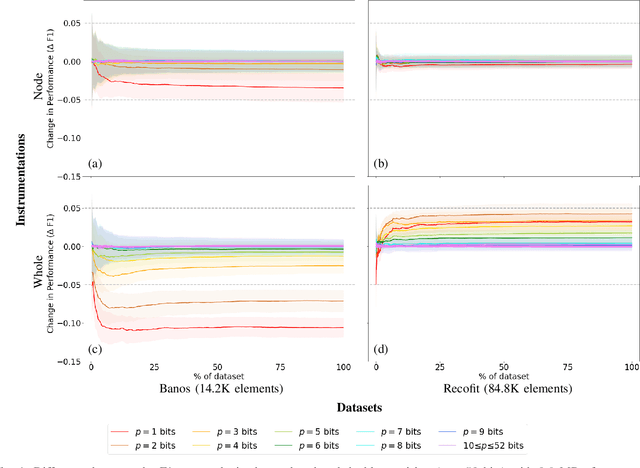
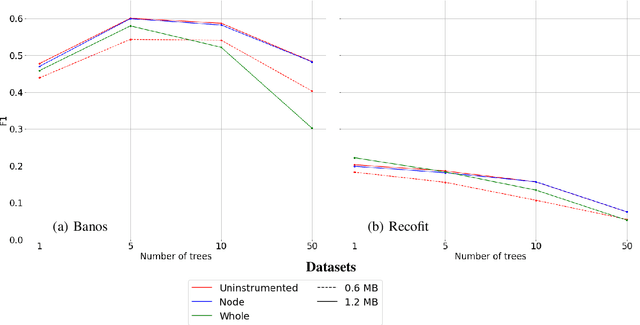

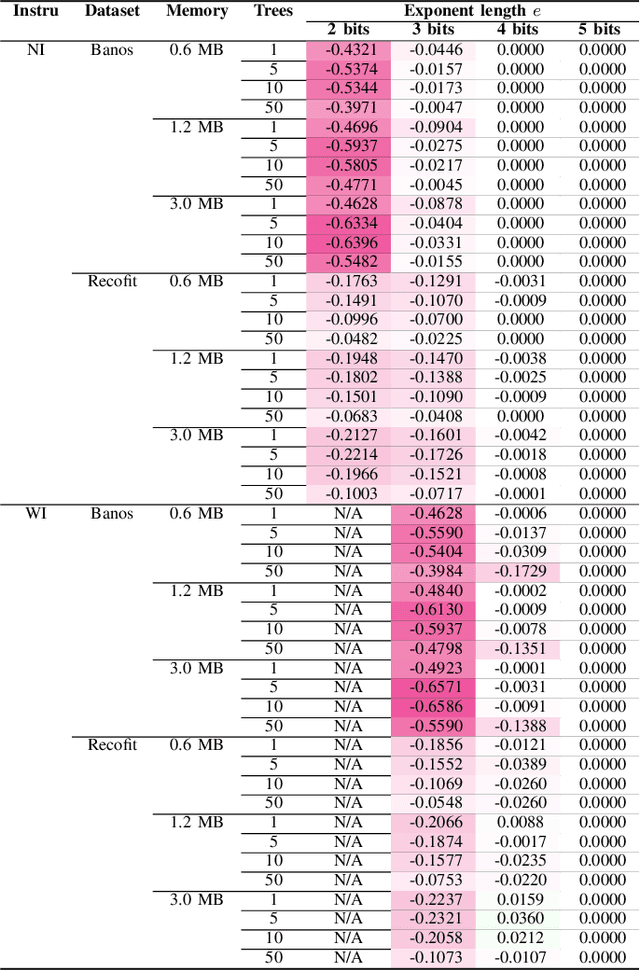
Abstract:Mondrian Forests are a powerful data stream classification method, but their large memory footprint makes them ill-suited for low-resource platforms such as connected objects. We explored using reduced-precision floating-point representations to lower memory consumption and evaluated its effect on classification performance. We applied the Mondrian Forest implementation provided by OrpailleCC, a C++ collection of data stream algorithms, to two canonical datasets in human activity recognition: Recofit and Banos \emph{et al}. Results show that the precision of floating-point values used by tree nodes can be reduced from 64 bits to 8 bits with no significant difference in F1 score. In some cases, reduced precision was shown to improve classification performance, presumably due to its regularization effect. We conclude that numerical precision is a relevant hyperparameter in the Mondrian Forest, and that commonly-used double precision values may not be necessary for optimal performance. Future work will evaluate the generalizability of these findings to other data stream classifiers.
 Add to Chrome
Add to Chrome Add to Firefox
Add to Firefox Add to Edge
Add to Edge